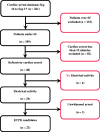A retrospective analysis of inpatient cardiac arrests over one year at a tertiary heart attack and cardiothoracic centre identifying potential candidates for an inpatient extracorporeal cardiopulmonary resuscitation service
- PMID: 32489405
- PMCID: PMC7238474
- DOI: 10.1177/1751143719848660
A retrospective analysis of inpatient cardiac arrests over one year at a tertiary heart attack and cardiothoracic centre identifying potential candidates for an inpatient extracorporeal cardiopulmonary resuscitation service
Abstract
Introduction: Extracorporeal cardiopulmonary resuscitation (ECPR) is an internationally recognised treatment for refractory cardiac arrest, with evidence of improved outcomes in selected patient groups from cohort studies and case series. In order to establish the clinical need for an in-hospital extracorporeal cardiopulmonary resuscitation service at a tertiary cardiac centre, we analysed the inpatient cardiac arrest database for the previous 12 months.
Methods: Evidence-based inclusion criteria were used to retrospectively identify the number of patients potentially eligible for extracorporeal cardiopulmonary resuscitation over a 12-month period.
Results: A total of 261 inpatient cardiac arrests were analysed with 21 potential extracorporeal cardiopulmonary resuscitation candidates meeting the inclusion criteria (1.75 patients per month, or 8% of inpatient cardiac arrests (21/261)). The majority (71%) of these cardiac arrests occurred outside of normal working hours. Survival-to-discharge within this sub-group with conventional cardiopulmonary resuscitation was 19% (4/21).
Conclusion: Sufficient numbers of refractory inpatient cardiac arrests occur to justify an extracorporeal cardiopulmonary resuscitation service, but a 24-h on-site extracorporeal membrane oxygenation team presents a significant financial and logistical challenge.
Keywords: Extracorporeal cardiopulmonary resuscitation; extracorporeal life support; extracorporeal membrane oxygenation.
© The Intensive Care Society 2019.
Figures
References
-
- Kagawa E, Inoue I, Kawagoe T, et al. Assessment of outcomes and differences between in- and out-of-hospital cardiac arrest patients treated with cardiopulmonary resuscitation using extracorporeal life support. Resuscitation 2010; 81: 968–973. - PubMed
-
- Chen YS, Lin JW, Yu HY, et al. Cardiopulmonary resuscitation with assisted extracorporeal life-support versus conventional cardiopulmonary resuscitation in adults with in-hospital cardiac arrest: an observational study and propensity analysis. Lancet 2008; 372: 554–561. - PubMed
-
- Reynolds JC, Grunau BE, Elmer J, et al. Prevalence, natural history, and time-dependent outcomes of a multi-center North American cohort of out-of-hospital cardiac arrest extracorporeal CPR candidates. Resuscitation 2017; 117: 24–31. - PubMed
-
- Kuroki N, Abe D, Iwama T, et al. Association between delay to coronary reperfusion and outcome in patients with acute coronary syndrome undergoing extracorporeal cardiopulmonary resuscitation. Resuscitation 2017; 114: 1–6. - PubMed
LinkOut - more resources
Full Text Sources

